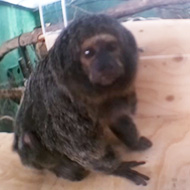
Researchers studied how white-faced sakis interacted with a computer interface.
Animal-computer interaction specialists at the University of Glasgow, UK and Aalto University, Finland, have explored how monkeys interact with audio and visual stimuli.
Computer-based enrichment systems are already being used in some zoos with primates, to provide the animals with interactions that stimulate their brain in similar ways to their wild counterparts.
Dr Ilyena Hirskyj-Douglas and Vilma Kankaanpää led the research, working with a group of three white-faced saki monkeys at Korkeasaari Zoo in Helsinki. They built a computer interface within a small tunnel made of wood and plastic, which was then placed into the monkeys' enclosure.
To allow the monkeys to trigger audio or visual stimuli on demand, the pair created three interactive zones within the tunnel using infrared sensors.
When the monkeys moved through an infrared beam, a video or sound would be triggered on a screen in front of them until they decided to leave the area.
After leaving the tunnel silent for seven days to allow the sakis to become accustomed to it, the tunnel was turned on, allowing them to choose between an audio or video stimulus which changed every few days.
Available for 18 days, the tunnel displayed stimuli such as rain sounds, music or traffic noise, or videos of worms, underwater scenes or abstract shapes and colours.
It was found that while the audiovisual elements of the tunnel were active, the sakis' interaction with it was short – mirroring the way they usually interact with their environment. However, they triggered audio stimuli twice as much in total as visual stimuli.
Of the videos, the sakis' watched the underwater one most frequently, and listened to music the most amount out of the audio files.
Explaining, Dr Hirskyj-Douglas said: “We’ve been working with Korkeasaari Zoo for several years now to learn more about how white-faced sakis might benefit from computer systems designed specifically for them.
“Previously, we have explored how they interacted with video content and audio content, but this is the first time we’ve given the option to choose between the two.
“Our findings raise a number of questions which are worthy of further study to help us build effective interactive enrichment systems. Further study could help us determine whether the short interactions were simply part of their typical behaviour, or reflective of their level of interest in the system.
“Similarly, their varying levels of interaction over time could be reflective of how engaging they found the content, or simply that they were becoming habituated to the tunnel’s presence in their enclosure.
“While they chose audio more regularly than video, the results weren’t statistically significant enough for us to know for sure what they prefer.”
Kirsi Pynnönen-Oudman, research coordinator at the Helsinki/Korkeasaari Zoo, commented: “Very little research has been done on the Pitheciidae-family monkeys and their enrichment at the zoos.
“This study on the white-faced saki monkeys gives us valuable data how to use different enrichment items for these New World monkeys.
“This kind of new information will help the conservation efforts of this species both in in the wild and in captivity.
“Sakis have a breeding program, called the EAZA Ex situ programmes, running in European zoos. The program coordinator visited our zoo recently and was very interested of the studies made on them using the computer based animal-driven choice tunnels.”
Images (C) University of Glasgow/Aalto University



 The RCVS has announced a new version of its 1CPD mobile app, with enhanced features for veterinary surgeons and veterinary nurses to record their continuing professional development.
The RCVS has announced a new version of its 1CPD mobile app, with enhanced features for veterinary surgeons and veterinary nurses to record their continuing professional development.